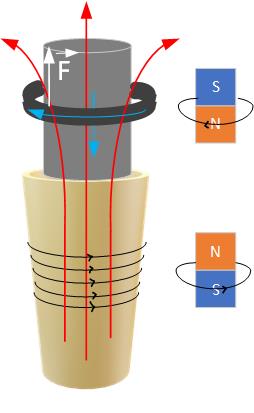Flying Ring
Flying ring is an experiment shown in Figure fig:FlyingRing. A fixed coil of N-turns is wound on a ferromagnetic core and energized by an AC generator. On top of the ferromagnetic core is a ring. Since the current is initially increasing in the coil, the magnetic field through the ring is increasing. The current in the ring will then produce an induced magnetic field to counteract the increase of the coil’s magnetic field. The current associated with the induced magnetic field will flow in the opposite direction from the coil’s current. When two currents are opposite, the wires repel each other so that the ring will fly off the electromagnetic core.
It is interesting to note that no matter whether the coil’s current is increasing or decreasing, the ring’s current will always be in the opposite direction. We will look here at this problem conceptually. Both ring and the coil represent two RL circuits. In the coil, the current lags voltage for . The flux in the coil is in phase with the current. The induced voltage in the ring will be lagging with respect to the coil’s flux. The induced voltage in the ring will establish a current lagging with the induced voltage. Therefore the currents in the coil and ring will always be out of phase. This is, of course, in cases where the internal resistance of the ring is minimal. In practice, the higher the resistance, the currents may not precisely be out of phase, but the force will still be repulsive on average.
